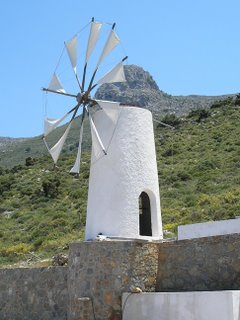what are the alternatives?
 Wind energy is abundant, inexhaustible, widely distributed, clean, and mitigates the greenhouse effect. In 2005, worldwide capacity of wind-powered generators was 58,982 megawatts, their production making up less than 1% of world-wide electricity use. Although still a relatively minor source of electricity for most countries, wind power generation more than quadrupled between 1999 and 2005.
Wind energy is abundant, inexhaustible, widely distributed, clean, and mitigates the greenhouse effect. In 2005, worldwide capacity of wind-powered generators was 58,982 megawatts, their production making up less than 1% of world-wide electricity use. Although still a relatively minor source of electricity for most countries, wind power generation more than quadrupled between 1999 and 2005.Most modern wind power is generated in the form of electricity by converting the rotation of turbine blades into electrical current by means of an electrical generator. In windmills (a much older technology) wind energy is used to turn mechanical machinery to do physical work, like crushing grain or pumping water.
Wind power is used in large scale wind farms for national electrical grids as well as in small individual turbines for providing electricity in isolated locations.
An estimated 1 to 3% of energy from the Sun that hits the earth is converted into wind energy. This is about 50 to 100 times more energy than is converted into biomass by all the plants on earth through photosynthesis. Most of this wind energy can be found at high altitudes where continuous wind speeds of over 160 km/h (100 mph) occur. Eventually, the wind energy is converted through friction into diffuse heat all through the earth's surface and atmosphere.
The origin of wind is simple. The earth is unevenly heated by the sun resulting in the poles receiving less energy from the sun than the equator does. Also the dry land heats up (and cools down) more quickly than the seas do. The differential heating powers a global atmospheric convection system reaching from the earth's surface to the stratosphere which acts as a virtual ceiling.
Rural communities are thought to welcome wind farms because they provide income to farmers and ranchers, skilled jobs, cheap electricity and additional tax revenue to upgrade schools and maintain roads.
Onshore turbine installations tend to be along mountain ridges or passes, or at the top of cliff faces. The change in ground elevation causes the wind velocities to be generally higher in these areas, although there may be variation over short distances (a difference of 30 m can sometimes mean a doubling in output). Local winds are often monitored for a year or more with anemometers and detailed wind maps constructed before wind generators are installed.
Offshore wind turbines are considered to be less unsightly since they can be invisible from shore. Because there are fewer obstacles and stronger winds, such turbines don´t need to be built as high into the air. However, offshore conditions are harsh, abrasive, and corrosive, and it is more difficult to maintain a turbine in open waters than on land. In areas with extended shallow continental shelves and sand banks (such as Denmark), turbines are reasonably easy to install, and give good service.
It has been suggested that wind turbines might be flown in high speed winds at high altitude. No such systems currently exist in the marketplace. An Ontario company, Magenn Power, Inc., is attempting to commercialize tethered aerial turbines suspended with helium.
Español | Deutsche | Français | Italiano | Português| Ch| Jp| Ko







0 Comments: